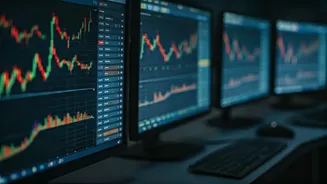Macro Factors and Markets
Rohit Srivastava presented a webinar focused on inter-market analysis, elaborating on how macroeconomic factors influence market direction. The session
probably explored the intricate relationships between various economic indicators, such as inflation rates, interest rate movements, and GDP growth, and their subsequent impact on different asset classes, including stocks, bonds, and commodities. The webinar likely aimed to equip investors with a deeper understanding of how these macro trends can inform their investment decisions, allowing them to anticipate market movements and adjust their portfolios accordingly. Inter-market analysis helps to understand how one market influences others.
Gold Investment Strategies
Somasundaram PR's webinar offered insights into gold investments, likely discussing gold's role as a safe haven asset and its importance in diversifying investment portfolios. The session could have examined various aspects of gold investing, potentially including different investment vehicles like gold ETFs, sovereign gold bonds, and physical gold. The webinar might have touched on factors influencing gold prices, like geopolitical events, inflation, and currency fluctuations, thereby providing participants with the knowledge to make informed decisions regarding gold investments and how to incorporate gold into a broader investment strategy.
Kagi Chart Analysis
Brijesh Bhatia presented a webinar on Kagi Charts, a technical analysis technique. The session explored the forgotten yet powerful tool for market analysis. Kagi charts are a visual method used to identify potential trends and reversals in price movements, differing from typical candlestick charts. The webinar likely highlighted how Kagi charts can help traders spot key support and resistance levels. It may have provided practical examples of how to interpret Kagi charts to make informed trading decisions, with the potential of gaining an edge in their market analysis by implementing this technique.
Multi-cap Funds Explained
R Srinivasan, Ruchit Mehta, Sukanya Ghosh, Priyanka Dhingra, Saurabh Pant, and Nidhi Chawla discussed multi-cap funds. This webinar probably explored the key features of multi-cap funds and their ability to provide a balance between growth and stability. The experts would have described how these funds invest across market capitalizations (large-cap, mid-cap, and small-cap companies). They probably provided details on how multi-cap funds can provide diversification benefits and how the asset allocation strategy adopted can influence the overall risk-return profile. The discussion may have included examples of how these funds can be used in different market conditions.
Multi Asset Allocation
Chintan Haria's webinar focused on investing in multi-asset allocation funds. This session likely delved into the core principles of multi-asset allocation, which involves diversifying investments across various asset classes, such as stocks, bonds, commodities, and real estate. The webinar would have elaborated on the benefits of multi-asset funds, highlighting how diversification can reduce overall portfolio risk and improve risk-adjusted returns. Practical aspects like selecting appropriate multi-asset funds and optimizing asset allocation strategies to align with individual financial goals may have also been included.
India's Growth Trajectory
Vaibhav Agrawal presented his views on India's growth prospects. The webinar probably analyzed the economic environment and growth drivers in India. It could have highlighted key economic indicators, government policies, and industry trends that suggest India is poised for significant economic growth. The session might have included an assessment of potential challenges or risks. This session likely offered valuable insights into the growth outlook, helping participants understand the opportunities and challenges in the Indian market.
Swing/Positional Opportunities
Bharat Sharma's webinar focused on identifying swing and positional trading opportunities. The session may have presented the concept of swing trading, which involves holding positions for a few days to weeks, and positional trading, which involves holding positions for a few weeks to months. The webinar might have explained how traders can use technical analysis tools, such as chart patterns, indicators, and trend lines, to identify potential opportunities. Sharma may have provided actionable insights into developing trading strategies, along with techniques for managing risk and maximizing profits in swing and positional trading.









